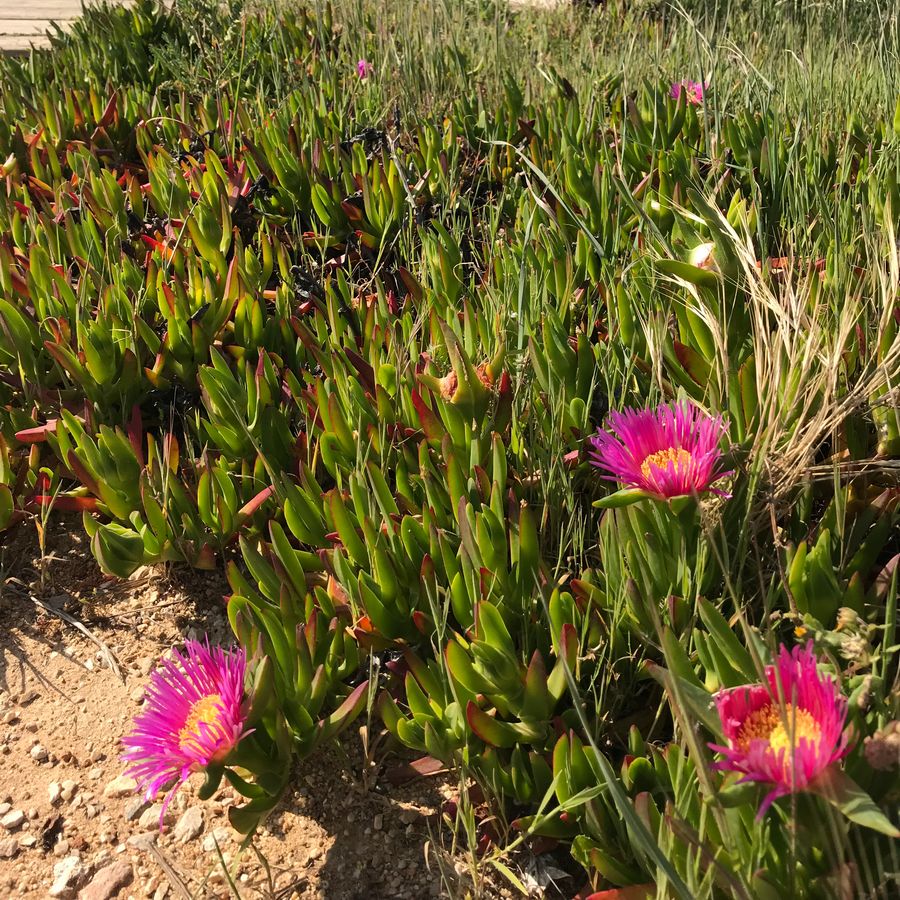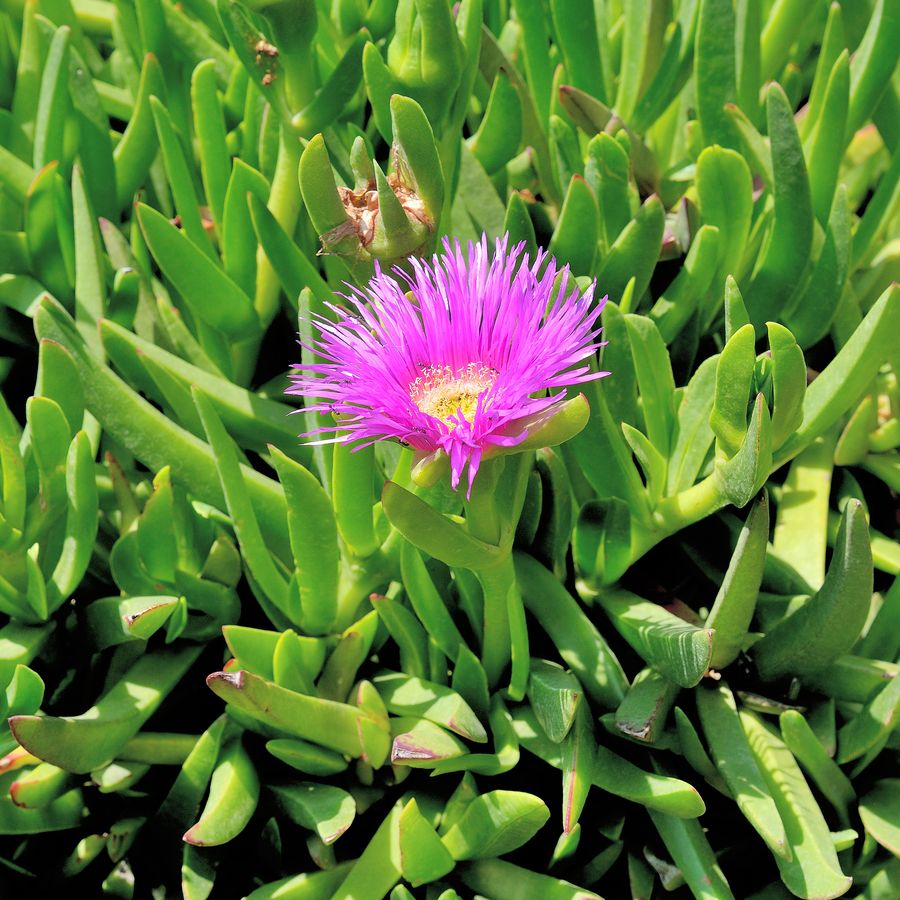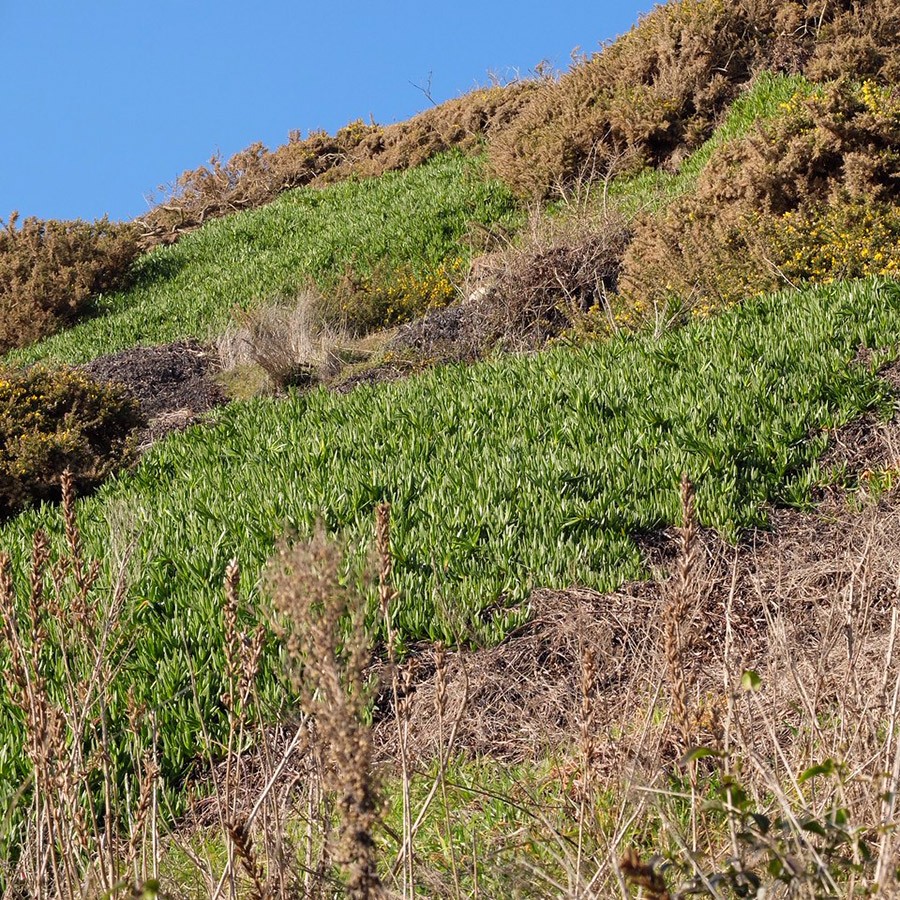Hottentot-Fig Control & Removal
Hottentot-Fig is a serious concern in coastal areas. Originating from South Africa. It has successfully established itself in the milder climate of the south and southwest coast of England where it has been left to spread across our eroding coastal cliffs.
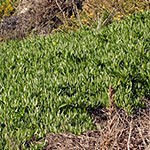 Above ground Hottentot-Fig
Above ground Hottentot-Fig
Succulent leaves in a triangular shape with large yellow flowers in summer that fade to pink. It is a fruit bearing plant but is unable to develop its fruits fully in the UK due to the climate being too cool. Hottentot-fig is a matt forming species that can spread up to 1m a year. The poor quality of soils and its ability to thrive in this environment mean that it out-competes other native plants and shrubs.
Below Ground Hottentot Fig
The root system is very shallow and stabilizes by its mat forming characteristic. It had been introduced in countries like Portugal ironically as coastal erosion control but by spreading quickly it denies other cliff dwelling plants and shrubs of habitat that may have deeper root systems, which can act as stabilizers for erosion effected cliff faces.
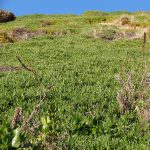 Hottentot fig is classified as an invasive non-native species (INNS): http://www.nonnativespecies.org
Hottentot fig is classified as an invasive non-native species (INNS): http://www.nonnativespecies.org
Hottentot fig or Carpobrotus edulis as it scientifically known comes under this classification for these reasons:
- Growth rate and size – outcompetes native flora
- Different reproductive cycles and methods – can self-pollinate
- Natural predators and pests – no native insects or herbivores are actively able control to plant quantities
The presence of Hottentot Fig effects the surrounding environment greatly by what is known as habitat modification:
- Deep forming matting characteristic can be up to 50cm in depth, creating an impenetrable barrier for other plants to grow through.
- Hottentot fig will increase the acidity levels of soils beneath it which can definitely exclude certain types of plants or shrubs from successfully establishing that require neutral to alkaline.
Hottentot Fig was first named and recorded the in the 17th century and was documented in the wild of the UK in 1886. It predominantly established itself in the south West of England coastal regions due to the milder climate. Hottentot fig is susceptible to frost but there is recorded presence further in the north of the country.
Hottentot Fig is a schedule 9 listed species in the wildlife and countryside act of 1981 which means there is legal obligation to prevent the spread in the wild of species that may have detrimental effects to ‘ecological, environmental, or socio-economic’ interests. There are 40 plants currently listed in schedule 9 of which Hottentot Fig is just one: http://www.ukwildlife.com/index.php/wildlife-countryside-act-1981/schedule-9/schedule-9-part-2/
How can we help you?
Can you survey for Hottentot Fig?
Yes, a request to survey will entail liaising onsite with a surveyor. Regardless if you know exactly where the Hottentot fig is on the property or land, or you have difficulty identifying it, the first contact and chat with you is incredibly useful as you can provide a great deal of historical and geographical information.
A thorough walk through of the site will reveal any evidence of Hottentot fig that can be accessed by foot. We would also be looking for clues and information as to how Hottentot Fig arrived at the location in the first place and how to prevent it from contaminating the rest of the property or land, this is known as biosecurity. The site will then be measured and any Himalayan Balsam plotted It will also be established as to any Hottentot Fig in neighbouring properties or land. It must be noted that due to Hottentot fig growing mainly in coastal cliff top locations access will only be made as close as Health and Safety allows and disturbances to delicate cliff faces by intrusion may cause more harm than good. We will look for alternative methods to record information in the safest and most unobtrusive manner.
I have looked at your website and I’m sure that I have Hottentot fig am I breaking the law by having it on my property?
It is not illegal for you to have Himalayan Balsam on your property but it is your responsibility take on the role of remediating the problem.
gnoring the problem will effect not just your property and its localised environment, but your neighbours properties and any others natural areas such as park land, water ways and areas of social or special interest. Failure to acknowledge your responsibility could bring you to the attention of local authorities and the police who have the power to issue Community Protection Notices:
https://www.gov.uk/guidance/prevent-the-spread-of-harmful-invasive-and-non-native-plants
Removing material from site that contains Hottentot Fig must be classified as controlled waste. It is illegal to dispose of controlled waste in the incorrect manner and without registering to do so and certainly disposing of Hottentot Fig controlled waste improperly, can result in prosecution.
What is entailed in the control and eradication of Hottentot Fig?
Hottentot Fig poses a challenge due to where it grows.
Removing by hand is effective as it can be easily up-rooted and essentially rolled up, left to dry and expire. This method is routinely used in the Mediterranean in countries such as Portugal where Hottentot fig is endemic. But it is the difficulty of access, safety and the disruption to delicate cliff faces that must be considered in each individual case. In the event that it is deemed suitable for the mechanical removal of Hottentot Fig, Bio-Securities must be established in the handling of material to prevent propagules spreading on site and through physical transportation to disposal
The removal of waste containing Hottentot Fig and disposal is classed as controlled waste.
Herbicide application has been proven to be effective in the control and eradication of Hottentot fig. Application by way of knapsack sprayer would be deemed the most effective. With repeated applications necessary. We will aim to develop a Hottentot Fig management plan that will factor access, site sensitivity and any environmental or ecological constraints.
Revegetation should always be a consideration once a management plan is in the completion phase .This is a crucial opportunity to reinstate biodiversity after an invasive attack and can also be an effective way to prevent other INNS from exploiting a vulnerable location.
What type of herbicides do you use? Are they harmful to humans and animals?
We use a glyphosate based herbicide which can only be obtained under licence and must pass through stringent health and safety testing.
There are no restrictions as regards to exclusion from the area for humans or animals after application. Glyphosate is a systemic, non-selective herbicide which only targets and inhibits certain enzymes in plants, vital for protein conversion, growth and cell integrity.
All our operatives must have passed a specific examination in the safe use of pesticides and herbicides before handling and applying to Hottentot Fig or any other INNS.
In the event that Hottentot Fig is close to water courses or ditches, application for consent will be made to the environment agency. Glyphosate is one of the very few herbicides that will be considered in use around water.
Glyphosate is also non residual meaning that it will dissipate on contact with soils and will not remain or contaminate. We follow closely, current legislation and would never actively use a product that put yourself, ourselves or animals at risk.
What areas of the UK do you cover?
Our invasive plants control and removal services cover the following counties: Dorset, Hampshire, Wiltshire, Bristol & Bath, Gloucestershire, Somerset and Devon.

